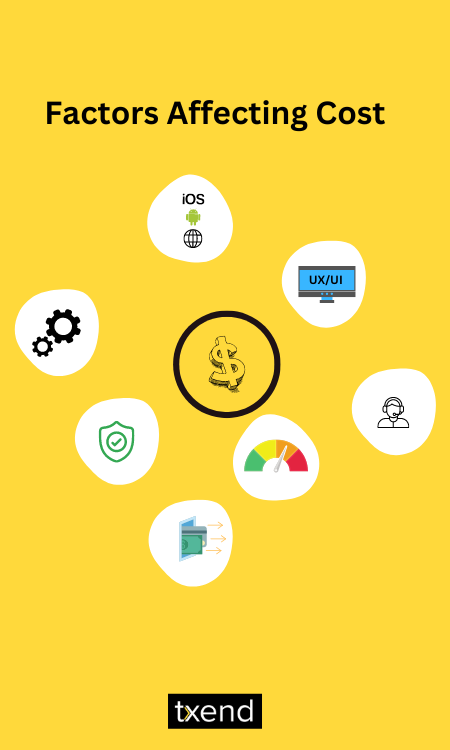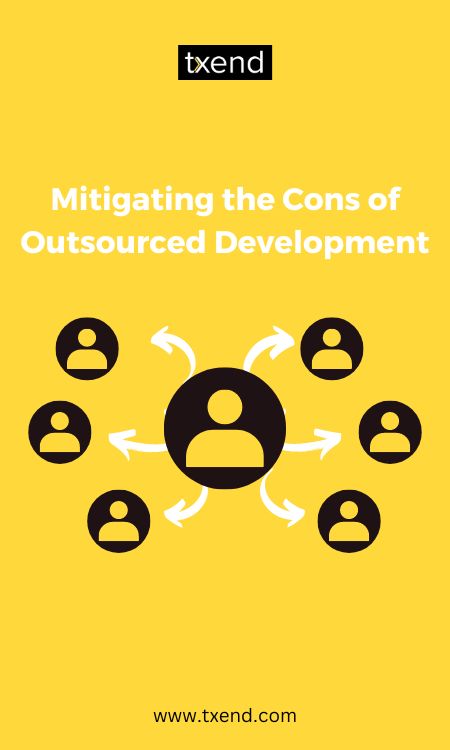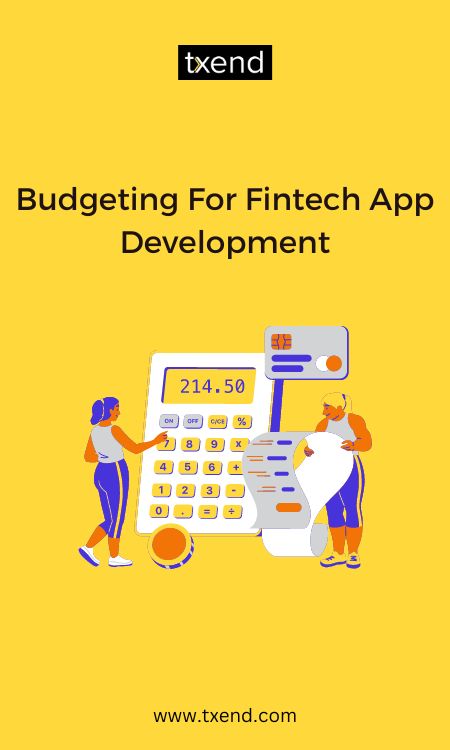Fintech App Development
Welcome to a strategic exploration of Fintech App Development Costs—a comprehensive guide designed to empower you with insights on budgeting and estimation in the dynamic world of financial technology.
As the fintech industry thrives and revolutionizes how we interact with financial services, the demand for innovative and user-centric apps has never increased. This guide will provide you with the essential knowledge to navigate the intricate landscape of costs associated with fintech app development.
In recent years, the fintech sector has experienced remarkable growth, attracting established companies and aspiring entrepreneurs to enter this transformative space.
With millions of users worldwide embracing fintech solutions for payments, investments, budgeting, and more, the market showcases an insatiable appetite for convenient and efficient financial tools.
Key Takeaways
- Fintech app development costs are influenced by complexity, features, security requirements, and regulatory compliance.
- The type of fintech app, such as payment, lending, or investment, significantly impacts development costs due to varying functionalities and integrations.
- A detailed cost breakdown includes design, development, testing, security, compliance, and ongoing maintenance.
- Outsourcing can be cost-effective, leveraging specialized skills, while in-house development offers more control but can be pricier.
- Effective budgeting considers development, marketing, maintenance, and compliance costs, aligning them with revenue projections.
- Additional costs may include licensing, third-party integrations, data storage, and scalability measures.
- Cost savings can be achieved through MVP development, efficient use of technology, and strategic outsourcing.
- Accurate cost estimation involves defining project scope, features, and technology stack, and consulting with experts.
- Fintech apps often utilize cloud computing, blockchain, AI, ML, and robust security measures to ensure functionality and data protection.
- FinTech app development involves idea validation, market research, design, development, testing, compliance, and launch.
- Challenges include regulatory hurdles, security concerns, competition, and evolving user expectations.
- Future trends may include increased adoption of cloud-native technologies and AI-driven automation, impacting development costs.
How much does it cost to develop a fintech app?
As fintech gains momentum, the question of “How much does it cost to develop a fintech app?” becomes increasingly relevant. This guide will highlight the key factors influencing fintech app development costs and offer strategic insights to help you budget effectively and make informed decisions.
This guide will arm you with the information and tactics to negotiate the complexity of fintech app development costs, whether you’re an experienced fintech expert or just starting out.
Let’s delve into the details, explore cost considerations, and chart a path toward successful budgeting and estimation in the vibrant realm of fintech app development.
Factors Influencing Fintech App Development Costs

In fintech app development, several crucial factors influence the costs of bringing your innovative financial solution to life. Understanding these factors is essential for effective budgeting and estimation.
Here’s a breakdown of the key elements shaping fintech app development costs:
Features and Functionality:
The complexity and scope of features embedded within your app extensively impact costs. Each feature adds to the development effort, from basic functionalities to advanced tools like investment tracking or real-time data analysis.
Platfllorm (iOS, Android, Web):
The choice of platform affects both development time and costs. Developing for multiple platforms adds complexity, while focusing on a single platform can lead to quicker deployment and lower costs.
Designing for User Interface and User Experience:
Crafting an intuitive and visually appealing UI/UX design enhances user engagement. However, intricate design elements, animations, and responsiveness may increase development costs.
Integration with Third-Party Services (Payment Gateways, APIs):
Integrating external services, like payment gateways or financial data APIs, can streamline functionality but may involve licensing fees and customization expenses.
Security and Compliance Requirements:
Fintech apps deal with sensitive financial data, demanding robust security measures. Meeting compliance standards such as GDPR or financial regulations increases development costs.
Customization and Personalization:
Tailoring the app to meet unique user preferences adds to development costs. Personalization features may involve complex algorithms or AI-driven recommendations.
Scalability and Performance:
Ensuring the app can handle increasing user loads and maintain optimal performance requires meticulous coding and infrastructure planning, influencing costs.
Cost Defined By The Types of Apps
When understanding the costs of fintech app development, it’s essential to recognize that different types of apps come with distinct requirements, intricacies, and, consequently, varying costs.
Here’s a breakdown of how the types of fintech apps can define their development costs:
Payment and Money Transfer Apps:
Approximation: $100,000 – $300,000
Payment and money transfer apps involve complex features like secure transactions, integration with payment gateways, and compliance with financial regulations. These apps require sophisticated security measures and robust backend systems.
Personal Finance Management Apps:
Approximation: $50,000 – $150,000
Personal finance management apps focus on helping users track expenses, manage budgets, and plan savings. They require intuitive user interfaces and backend databases to handle financial data securely.
Investment and Trading Apps:
Approximation: $150,000 – $500,000
Investment and trading apps demand real-time data, intricate charting, and secure trading mechanisms. They often require integration with financial data sources and compliance with market regulations.
Peer-to-Peer Lending Platforms:
Approximation: $200,000 – $600,000
Peer-to-peer lending apps involve complex backend processes for borrower-lender matching, credit checks, and transaction management. Ensuring data security and regulatory compliance is crucial.
Insurtech Apps:
Approximation: $100,000 – $300,000
Insurtech apps provide insurance-related services such as quotes, policy management, and claims processing. They require secure data handling and integration with insurance databases.
Robo-Advisory Apps:
Approximation: $150,000 – $400,000
Robo-advisory apps automate investment advice based on user preferences. They involve algorithm development, integration with financial data sources, and ensuring accurate financial recommendations.
Digital Wallets and NFC Payment Apps:
Approximation: $50,000 – $200,000
Digital wallets and Near Field Communication (NFC) payment apps allow users to make contactless payments. They require integration with payment systems and technologies like NFC.
RegTech Apps:
Approximation: $100,000 – $300,000
Regtech apps focus on helping financial institutions comply with regulations. They involve complex data analysis, reporting, and integration with various regulatory frameworks.
These cost estimates are only estimations and may change depending on the complexity of the features, the level of customization, the security needs, and the technological stack. To obtain a more accurate estimate for the particular kind of app you’re contemplating, it’s crucial to undertake in-depth research and speak with experts with fintech app development experience.
Step-by-Step Cost Breakdown For Fintech App Development

1- Design and User Experience Costs:
Approximation: $10,000 – $50,000
Design and user experience costs cover creating a visually appealing and user-friendly interface for your fintech app. This includes wireframing, UI/UX design, graphic elements, and creating a seamless user journey.
2- Development Costs (Front-end and Back-end):
Approximation: $50,000 – $200,000
Development costs encompass the development of the front-end (user interface) and back-end (server-side logic). Front-end development involves coding the visual elements users interact with, while back-end development handles server setup, databases, and business logic implementation.
3- Third-Party Integration Costs:
Approximation: $5,000 – $30,000
Third-party integration costs include expenses for incorporating external services and APIs into your app. This can range from payment gateways and authentication services to analytics and social media integration.
4- Testing and Quality Assurance Costs:
Approximation: $10,000 – $40,000
Testing and quality assurance costs ensure that your app functions correctly, is free of bugs, and provides a smooth user experience. This includes manual and automated testing, identifying and fixing issues, and optimising performance.
5- Security and Compliance Costs:
Approximation: $15,000 – $50,000
Security and compliance costs involve implementing measures to safeguard user data, prevent breaches, and ensure regulatory compliance. This includes encryption, secure authentication, and adherence to industry standards and regulations.
6- Maintenance and Updates Costs:
Approximation: 15% – 25% of initial development cost per year
Maintenance and update costs cover ongoing support, bug fixes, updates, and improvements to keep your fintech app up-to-date and running smoothly. This is a continuous expense to ensure the longevity and relevance of your app.
Remember that these approximate cost ranges vary widely based on app complexity, features, technology stack, development approach (in-house vs. outsourcing), and market rates. To get a more precise estimate that is suited to your particular project and goals, do extensive research and speak with industry professionals.
In-House Development
vs
Outsourced Development
In-House Development:
In-house development refers to building your fintech app using your internal resources, such as hiring and managing your development team.
Pros
- Control: You have direct control over the development process, allowing you to make real-time changes and adjustments.
- Domain Knowledge: Your in-house team can better understand your company’s needs and goals.
- Communication: Direct communication can help prevent misunderstandings and streamline decision-making.
Cons
- Cost: In-house development can be more expensive due to salaries, benefits, office space, and equipment costs.
- Expertise: Finding and retaining skilled developers can be challenging and time-consuming.
- Time-Consuming: Building an experienced team and ramping up development can delay the app launch.
Outsourced Development:
Outsourced development involves hiring a third-party company or freelancers to handle the app development process.
Pros
- Savings: Since you won’t have to pay for staffing or infrastructure, outsourcing is frequently more affordable.
- Accessibility to Professionalism: You get access to a professional team with experience in developing fintech applications.
- Faster Development: Professional outsourced teams can expedite development, ensuring quicker time-to-market.
- Scalability: Outsourcing enables you to scale up or down based on project requirements without the hassle of recruitment.
Cons
- Communication Challenges: Time zone differences and remote collaboration can lead to communication challenges.
- Less Control: You have less control over the development process than an in-house team.
- Dependency: You rely on external partners; if the relationship sours, it could impact your project.
When considering whether to go with in-house or outsourced development, assessing your company’s resources, budget, timeline, and specific project requirements is essential.
Both approaches have merits and drawbacks, so choosing the one that best aligns with your strategic goals is crucial.
Remember, each project is unique, and the decision might vary based on factors like the app’s complexity, the urgency of deployment, and your team’s technical capabilities. Before making a choice, it is wise to carefully consider the advantages and disadvantages.
Mitigating the Cons of Outsourced Development

Certainly, here are the mitigation strategies for the cons associated with outsourced development:
Communication Challenges:
Regular Communication Schedule:
Establish a fixed communication schedule that aligns with overlapping working hours, ensuring timely updates and issue resolution.
Unified Collaboration Tools:
Implement centralized collaboration tools, project management systems, and communication platforms for seamless interaction across time zones.
Clear Documentation:
Maintain comprehensive documentation for project requirements, goals, and expectations to minimize misunderstandings.
Less Control:
Detailed Project Plan:
Develop a comprehensive project plan that outlines the app’s development stages, milestones, and expected outcomes. Regularly review progress against the plan.
Frequent Updates:
Set up regular status updates and review meetings with the outsourced team to stay informed about project progress and ensure alignment with your vision.
Dependency
Diversify Partnerships:
Avoid relying solely on one outsourcing partner. Engage with multiple vendors to diversify risk and have alternatives if issues arise.
Contractual Safeguards:
Incorporate robust contracts that outline deliverables, timelines, and dispute resolution mechanisms. Clearly define exit strategies in case the partnership turns sour.
By implementing these strategies, you can effectively address the challenges associated with outsourced development. Clear communication, structured project management, and contractual safeguards will enable you to maintain control, manage dependencies, and navigate the potential hurdles in your fintech app development journey.
Budgeting For Fintech App Development

Developing a Reasonable Budget:
The success of your FinTech app development project depends on your ability to set a budget that is feasible It involves estimating the overall costs accurately and ensuring that your budget aligns with the scope and complexity of your project.
When setting a budget, consider:
Project Scope:
Clearly define the features and functionalities you want your app to have—the more complex the features, the higher the development costs.
Market Research:
Research similar fintech apps to get an idea of the average development costs in the industry.
Development Team:
Determine whether you’re hiring in-house developers or outsourcing, and calculate the associated costs, including salaries, benefits, and any third-party fees.
Infrastructure:
Include servers, software licenses, and other technical infrastructure expenses.
Design and Testing:
Factor in costs for UI/UX design, user testing, and quality assurance to ensure a polished product.
Marketing and Launch:
Consider marketing, app launch, and initial user acquisition expenses.
Allocating Resources for Different Development Phases:
Fintech app development occurs in several phases, and it’s essential to allocate resources accordingly to ensure a smooth process.
Phases include:
Conceptualization and Planning:
Budget for initial research, requirement gathering, and project planning.
Design and Prototyping:
Allocate resources for creating wireframes, UI/UX design, and interactive prototypes.
Development:
Budget for coding, backend development, integration of features, and front-end development.
Testing and Quality Assurance:
Allocate resources for thorough testing, bug fixing, and ensuring app stability and security.
Deployment and Launch:
Plan for expenses related to app launching on app stores and marketing efforts.
Contingency Planning for Unforeseen Expenses:
Even with thorough planning, unexpected expenses can arise during fintech app development. It’s wise to have a contingency plan in place.
Consider:
Buffer Budget:
Allocate a portion of your budget as a buffer for unforeseen expenses. A common approach is to set aside around 10-20% of the total budget.
Scope Changes:
Understand that project scope can change during development. Be prepared for additional costs if new features or changes are requested.
Market Shifts:
External factors like market trends or regulatory changes could impact your app’s development or launch strategy.
Setting up a contingency plan ensures your project can adapt to unexpected challenges without derailing the entire budget.
Other Costs in Fintech App Development
Licensing and Intellectual Property Costs:
Approximation: $5,000 – $20,000 (Varies based on complexity)
Licensing and intellectual property costs encompass expenses related to software licenses, patents, trademarks, and copyrights.
Depending on your technologies and tools, you might need to pay for permits to use specific software components, frameworks, or APIs. Protecting your app’s intellectual property through patents or trademarks also incurs costs.
Ongoing Maintenance and Updates:
Approximation: 15% – 25% of initial development cost per year
Maintaining your financial app’s functionality, security, and alignment with the most recent industry standards requires regular upkeep and updates. This covers feature upgrades, security updates, performance improvements, and bug fixes. Set aside some of your budget to pay for these ongoing upgrades.
Regulatory Compliance Costs:
Approximation: $10,000 – $50,000 (Varies based on industry regulations)
Fintech apps often need to adhere to regulatory standards and compliance requirements, such as data security (e.g., GDPR, CCPA), financial regulations (e.g., SEC, FINRA), and payment processing standards (e.g., PCI DSS). Legal consultations, compliance audits, and implementing necessary measures can increase costs.
Data Storage and Hosting Expenses:
Approximation: $1,000 – $5,000 per month
Data storage and hosting costs depend on factors like the amount of data your app processes, the number of users, and the level of security required. These expenses cover cloud hosting services, database management, data backups, and ensuring data privacy compliance.
Please be aware that these price ranges are only approximations and may change depending on your fintech app’s particular features, complexity, and current market prices.
To obtain a more accurate estimate for the particular kind of app you’re contemplating, it’s crucial to undertake in-depth research and speak with experts with fintech app development experience.
Cost-Saving Strategies for Fintech App Development

Minimum Viable Product (MVP) Approach:
The MVP approach involves launching an initial version of your fintech app with a core set of features that address the most critical user needs.
This allows you to validate your app’s concept and gather user feedback while saving on development costs. By focusing on essential functionalities, you can reduce development time and expenses and later iterate and enhance the app based on real-world user insights.
Open Source Tools and Libraries:
Leveraging open-source tools, frameworks, and libraries can significantly reduce development costs. These resources are often free to use and have a community of developers contributing to their improvement.
Incorporating open-source solutions for UI components, database management, and security can accelerate development and save on building everything from scratch.
Reusing Components and Code:
Reusing components and code snippets from previous projects or open-source repositories can streamline development and cut costs.
By adopting modular design principles, you can create a library of reusable components that save time and effort in building similar functionalities. This approach also enhances consistency and reduces the risk of errors.
Cloud Services for Infrastructure:
Affordable hosting, data storage, and server administration options are offered by cloud services like Microsoft Azure, Amazon Web Service (AWS), or Google Cloud. Using cloud services eliminates the need for investing in and maintaining physical infrastructure, reducing upfront costs and enabling scalability based on your app’s growth.
When implementing these cost-saving strategies, balancing minimizing expenses and delivering a high-quality, user-friendly fintech app is essential. Careful planning, clear communication, and focus on essential features will help you optimize your development process and budget.
Estimating Fintech App Development Costs
Cost Estimation Tools and Techniques:
Various tools and techniques can assist in estimating fintech app development costs:
Analogous Estimation:
This involves using data from similar past projects to estimate the current project’s costs.
Bottom-Up Estimation:
You break down the project into smaller tasks and estimate costs for each, then sum them up for the total project cost.
Parametric Estimation:
This method uses mathematical models and parameters to estimate costs based on specific project attributes.
Online Estimation Tools:
There are online calculators and tools designed to provide rough estimates based on the features and complexity of your app.
Creating a Detailed Project Scope:
Defining a detailed project scope is critical for accurate cost estimation. This includes:
Feature List:
Identify and list all the features your fintech app will include, from basic functionalities to more complex components.
User Stories:
In order to comprehend how individuals interact with the application and what features they require, break features down into user stories.
Technical Requirements:
Specify the technologies, platforms, and integrations your app will use, as these influence development costs.
Design Elements:
Outline the UI/UX design requirements and any custom graphics or animations.
Getting Quotes from Development Partners:
Seeking quotes from development partners is a practical way to get accurate cost estimates:
Outsourcing Firms:
If you’re considering outsourcing, contact development firms with your detailed project scope to get tailored quotes.
Freelancers:
If hiring freelancers, provide them with a clear project description to receive quotes based on their skills and availability.
In-House Teams:
If you’re using an in-house team, work with them to estimate costs based on labor, infrastructure, and resources required.
Combining these approaches can give you a comprehensive understanding of potential development costs. Remember that while estimation is essential, there can always be unforeseen variables that affect costs during the actual development process. Therefore, it’s wise to include a contingency in your budget to account for unexpected expenses.
Technologies used to create a FinTech app
Programming Languages:
JavaScript:
Used for front-end development, JavaScript frameworks like React and Angular provide interactive user interfaces.
Python:
Often chosen for backend development due to its readability and versatility.
Java:
Known for its reliability and security, Java is commonly used for building complex fintech applications.
Swift (iOS) and Kotlin (Android)
Swift (iOS) and Kotlin (Android) are preferred languages for developing fintech apps specifically for iOS and Android platforms.
Front-End Development:
HTML/CSS:
The foundation of web development, HTML defines the structure, and CSS handles the styling of the app’s user interface.
React Native:
Enables building mobile apps using JavaScript, allowing for code reuse across platforms like iOS and Android.
Flutter:
A framework by Google for building native apps with a single codebase, providing high-quality UI experiences.
Back-End Development:
Node.js:
A popular runtime environment for executing JavaScript on the server side, often used for real-time applications.
Ruby on Rails:
Known for its rapid development capabilities, it’s suitable for creating fintech apps quickly.
Django:
A Python-based framework that emphasizes simplicity and follows the DRY (Don’t Repeat Yourself) principle.
Databases:
SQL Databases (e.g., MySQL, PostgreSQL):
Suitable for structured data storage, crucial for securely managing financial and user information.
NoSQL Databases (e.g., MongoDB, Cassandra):
Used for unstructured or semi-structured data storage, helpful for flexibility and scalability.
APIs and Integration:
RESTful APIs:
RESTful APIs Commonly used to facilitate communication between different components of the app and external services.
OAuth:
Used to handle secure authorization and authentication, crucial for fintech apps running sensitive user data.
Get Your Cost Effective App
Security Measures:
HTTPS:
Ensures secure communication over the internet, which is vital for protecting sensitive financial data during transactions.
Encryption:
Protects user data by converting it into unreadable code until decrypted by authorized parties.
Tokenization:
Reduces the danger of actual data being exposed during transactions by substituting sensitive data with distinctive tokens.
These technologies provide the foundation for developing secure, user-friendly, and functional fintech apps. The choice of technologies depends on factors such as the app’s complexity, target platforms, security requirements, and your development team’s expertise.
How to Develop a FinTech Application?
Developing a fintech application involves a strategic and systematic approach to ensure its success. Here’s a brief overview of the steps to develop a fintech app:
Idea and Research:
Identify a unique idea. To confirm its viability, conduct market, target market, and competitor research.
Conceptualization:
Define the app’s purpose, features, and functionalities. Create a detailed project scope that outlines technical requirements and user experience.
Design:
Develop wireframes and mockups for the user interface (UI). Create an interface that is simple to use and consistent with your brand.
Development:
Write the code for both the front-end (user interface) and back-end (server logic). Use appropriate programming languages and frameworks.
Integration:
Integrate APIs and third-party services for payment processing, data aggregation, and any required functionalities.
Testing:
Thoroughly test the app for bugs, glitches, and security vulnerabilities. Conduct user testing to ensure a smooth user experience.
Launch:
Deploy the app on relevant platforms such as app stores. Prepare marketing strategies for the launch.
User Feedback:
Gather feedback from users and analyze app performance. Implement improvements and updates based on feedback.
Security and Compliance:
Implement strong security measures to safeguard user data and guarantee adherence to industry standards.
Maintenance:
Continuously monitor and maintain the app. Regularly update features, fix bugs, and enhance user experience.
Developing a fintech app requires collaboration between designers, developers, and domain experts. Be prepared for challenges and iterate on your app using real-world usage and feedback.
Challenges in FinTech Application Development Process

There are a number of difficulties that must be carefully considered and planned for while creating a FinTech application. Here are several significant difficulties to be aware of:
Security and Compliance:
Fintech apps handle sensitive financial data, making security and regulatory compliance paramount. Meeting industry standards and adhering to data protection laws can be complex and resource-intensive.
Complexity:
Fintech apps often involve intricate financial processes, requiring thorough understanding and precise implementation of various financial transactions, calculations, and integrations.
User Trust:
Gaining user trust is crucial. Given the sensitivity of financial operations, fintech apps must provide secure, reliable, and transparent services to build user confidence.
Rapid Technological Changes:
The fintech landscape evolves rapidly. Staying up-to-date with new technologies, trends, and compliance requirements is challenging yet essential for maintaining competitiveness.
Integration Challenges:
Integrating with external financial systems, APIs, and payment gateways can be technically demanding due to varying protocols and formats.
Data Privacy:
Managing user data and ensuring its privacy is vital. Developing proper data encryption, storage, and handling processes is challenging, especially with changing regulations.
Scalability:
Fintech apps need to handle potentially high user volumes and transaction loads. Ensuring the app’s architecture supports scalability without compromising performance is a significant challenge.
User Experience:
Fintech apps must provide a seamless user experience. Balancing complex functionalities with an intuitive interface requires careful design and testing.
Cost Management:
Estimating and managing costs accurately is crucial. Unforeseen expenses during development, testing, or post-launch maintenance can impact budgets.
Regulatory Legal compliance:
Strict restrictions apply to the financial sector. Ensuring the app aligns with these regulations across different regions can be complex and time-consuming.
Navigating these challenges requires a multidisciplinary team, thorough planning, ongoing communication, and adaptability. By addressing these challenges strategically, fintech app developers can create robust and successful applications that cater to user needs while maintaining security and compliance.
Future Trends in Fintech App Development Costs
Impact of Emerging Technologies:
Blockchain and artificial intelligence (AI) are ready to transform the fintech industry, which will have an impact on development costs:
Blockchain:
While blockchain can enhance security and transparency, its complex nature may lead to higher initial development costs. However, it could reduce costs in the long run by minimizing intermediaries and streamlining processes.
AI and Machine Learning:
AI and Machine Learning, Integrating AI-driven features can improve user experience and automate tasks. Initial development costs may increase due to AI expertise requirements, but over time, AI can optimize processes and potentially lower operational costs.
Evolving Security and Compliance Standards and Their Financial Implications:
As fintech regulations evolve, security and compliance standards become more rigorous. This may impact development costs in several ways:
Higher Development Standards:
Meeting stringent security and compliance requirements can lead to additional development efforts, potentially increasing costs.
Ongoing Audits and Updates:
Regular compliance audits and updates to adhere to changing regulations may necessitate ongoing expenses, impacting long-term budgeting.
Data Privacy Investments:
Stricter data privacy regulations might lead to investments in robust encryption and data handling measures, adding to development and maintenance costs.
How Txend Can Help you in Developing a cost Effective Fintech App?
Txend offers a comprehensive solution for businesses looking to develop fintech apps while optimising costs. With its specialised expertise and tailored approach, Txend can guide you through the intricacies of fintech app development, ensuring a budget-friendly yet high-quality outcome.
Strategic Planning:
Txend collaborates closely with you to understand your app’s unique goals and requirements. By focusing on essential features and functionalities through a Minimum Viable Product (MVP) approach, Txend helps you launch quickly and cost-effectively while offering users value.
Technology Optimization:
Leveraging open-source technologies, reusable components, and efficient coding practices, Txend minimises development costs without compromising the app’s performance, security, or user experience.
Expertise in Emerging Technologies:
Txend stays at the forefront of emerging technologies like blockchain, AI, and cloud services. Strategically incorporating these innovations into your app can enhance functionality and efficiency while managing potential cost escalations.
Compliance and Security:
Txend is well-versed in evolving compliance and security standards. By designing and implementing robust security measures, Txend ensures your app meets regulatory requirements without incurring substantial post-development costs.
Ongoing Maintenance:
Txend’s approach extends beyond development. They provide ongoing maintenance and support, addressing issues promptly and helping you manage unforeseen expenses efficiently.
With Txend’s collaborative approach and commitment to value-driven development, you can navigate the complexities of fintech app development costs. You can create a fintech app that is competitively superior and cost-effective by matching your objectives with their areas of expertise.
Moreover, The “skin-in the game” strategy involves aligning the interests of stakeholders, particularly developers, with the success of the project. In the context of fintech app development, it signifies that developers have a vested interest in the app’s success, often by having a financial stake in the outcome.
Txend can play a pivotal role in implementing the “skin-in the game” strategy. By partnering with Txend for fintech app development, you not only gain access to their expertise but also a unique opportunity to become an equity owner if the application goes live. This strategy enhances collaboration and motivation, as Txend’s success becomes intertwined with yours.
By sharing in the potential gains and losses, both parties are aligned in their efforts to create a successful and impactful fintech app. Txend’s commitment to the project’s success translates into a focused and dedicated approach to development, ultimately benefiting you as the app owner.
Incorporating the “skin-in the game” strategy through Txend’s offer of equity ownership can foster a symbiotic relationship, where the development team’s dedication is paralleled by the prospect of shared rewards.
This approach not only adds a strong incentive for excellence but also fosters a sense of collective ownership and shared success throughout the app’s lifecycle.
Frequently Asked Questions
Building a basic FinTech app can cost around $20,000 to $50,000, depending on features and development resources.
Considering features, design complexity, and technology, developing an average FinTech app may range from $50,000 to $150,000.
Creating a complex FinTech app with advanced functionalities can cost $150,000 or more, accounting for intricate features, security, and compliance.
To stay within budget and avoid cost overruns, define a clear project scope, use cost-effective technologies, plan for contingencies, and collaborate closely with your development team.
Measure ROI by tracking user acquisition, engagement, transaction volume, and cost savings. Analyse revenue generated against development and operational expenses to evaluate your fintech app’s success.
Conclusion:
In conclusion, understanding and managing fintech app development costs are pivotal for a successful venture. By leveraging informed budgeting strategies and estimation techniques, businesses can navigate the intricacies of fintech app development cost-effectively.
With a strategic guide, “Navigating Fintech App Development Costs,” organizations can embark on their fintech journey with confidence and financial prudence.



